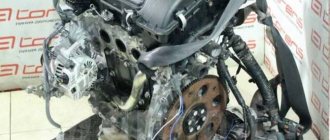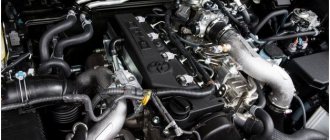— a specialized enterprise for servicing vehicles with CVT gearboxes. With us you can take advantage of a full range of services, ensure uninterrupted operation of the clutch system, and extend the service life of the variator.
Please note that repairing a Toyota RAV 4 CVT is a fairly complex task that requires the use of professional equipment and the participation of specialists with appropriate qualifications. An attempt to independently eliminate problems that have arisen will most likely only lead to the emergence of new technical problems or even failure of the device.
Therefore, do not risk the condition of your vehicle, and at the first sign of a faulty clutch, come to us for professional repair of the Toyota RAV 4 variator. Our employees will accurately determine the source of the problem and fix it quickly and at minimal cost.
Prices
| Service | Price |
| Diagnostics of Toyota RAV4 variator (computer with consultation) | For free |
| Tow truck to service within the Moscow Ring Road | For free |
| Automatic transmission adaptation after repair | For free |
| Toyota RAV 4 CVT repair (disassembly, troubleshooting, assembly) | 12,000 rub. |
| Removing and installing a variator ( front- wheel drive) | 9,000 rub. |
| Removing and installing a variator ( all-wheel drive) | 15,500 rub. |
| Valve block repair (turnkey) | 25,000 - 45,000 rub. |
| Checking solenoids (Kinergo stand) | 1,000 rub. per piece |
| Diagnostics of the valve body (Kinergo stand) | 7,000 rub. |
| Removing and installing the variator valve body | 4,500 rub. |
| Repair of mechatronics of a variator (if there is mechatronics in your type of variator) | 25,000 - 60,000 rub. |
| Changing the oil in the variator (work) | 2,200 - 2,700 rub. |
| Repair of variator torque converter (donut, gas turbine engine) | 11,000 - 18,000 rub. |
| Replacing the variator differential | from 25,000 rub. |
| Contract variators (if available in stock) | 60,000 - 140,000 rub. |
| Average cost of overhaul of a Toyota RAV4 CVT | 85,000 - 110,000 rub. |
Specifics of repair of the Toyota RAV 4 variator (Toyota RAV 4)
In most cases, in our practice, owners of cars with CVT transmissions turn to us to repair the Toyota RAV 4 CVT at the first sign of a malfunction, without waiting for more serious consequences. As a rule, the reason for contacting is the increased noise of the operating variator, as well as constant or occasional vibration.
As the practice of our work shows, the automatic transmissions of such cars are quite reliable and, with proper care, are designed for long-term operation. Here are the most common types of malfunctions of such devices:
- Belt breakage - this can happen due to its wear or due to excessive load on the clutch system.
- Malfunctions of the control module - troubleshooting such problems requires the use of special equipment and software.
- Failure of support bearings - the bearings on which the variator cones are supported experience high loads, so they wear out quickly. Wear products can clog the hydraulics and cause damage to other structural elements.
- Problems with the hydraulics – this can include problems with the pump, clogged filters, and others.
- Electrical wiring breaks, problems with sensors. Often, malfunctions in electrical systems occur due to contamination or oxidation of contacts.
These and other types of faults are successfully eliminated by our craftsmen using high-quality materials and professional high-precision equipment. We are ready to guarantee our customers not only excellent quality and reliability, but also the most affordable cost of service when repairing a Toyota RAV 4 CVT.
Repair time
It is possible to speed up the deadlines if you make an appointment in advance.
| Service | Honest deadlines |
| Overhaul of Toyota RAV4 CVT | The actual repair time is 1-3 days*. |
| Valve block repair** | 1-2 days*** (exchange possible) |
| Torque converter repair** | 1-2 days*** |
*There are already restored units prepared for installation, then the repair period will be reduced to 1 day. **for a separately provided service ***depending on the complexity and availability of replacement funds
The VAG-ID service center carries out maintenance and repair of CVTs of any modification. We will deliver your car on a tow truck for free and perform comprehensive diagnostics (the service is also provided free of charge). After the repair, you will receive a 1.5 year warranty. Our team consists of experienced craftsmen who can handle breakdowns that other specialists in Moscow cannot handle.
Toyota RAV4 CVT repair includes the following steps:
- Diagnostics. Determination of error codes using a scanner, visual inspection, hydraulic assessment, test drive.
- Coordination. The technician will draw up a defect sheet, announce the cost of the repair and the time frame for its completion.
- Repair. If you are satisfied with the price, then the specialist proceeds to repair work (removes the box, sorts it out, washes it, replaces consumables, worn parts or components, and then installs the box back into the car).
- CVT setting and diagnostics. At the final stage, a re-evaluation of the system operation is carried out.
- Payment and receipt of a warranty card.
You can be present during the repair and ask the technician clarifying questions. He can also send you video reports via WhatsApp messenger.
Replacement process
For safety reasons, you should remove the keys from the ignition and remove the negative terminal of the battery. It's also a good idea to let the engine cool down, otherwise you risk getting burned when replacing it. To replace you will need the following tools:
- Heads for 14 and 12;
- Key for 10 and 14;
- Ratchet;
- Two cardans;
- Ratchet extension.
There is no need to completely remove the engine for replacement.
Replacing the drive belt on Rav 4 proceeds according to the following algorithm:
- Remove the nine clips and remove the radiator support cap.
- Remove the three clips and the decorative engine cover.
- Unscrew the two bolts and disconnect the radiator expansion tank.
- Remove 2 bolts, 4 screws and 10 clips, then remove the engine bottom cover.
- Remove the two clamps and remove the lower engine protection.
- Unscrew the four bolts and remove the front suspension beam mount.
- Release the tension by turning the tensioner pulley and then remove it.
- Fix the tensioner by aligning it with the hole and inserting a 5mm hex key into them.
- Replace the belt and tighten it.
The assembly follows the same plan, but in reverse order.
Typical CVT malfunctions
Toyota RAV4 CVTs have several “classic” faults:
- Seal leak.
- Worn solenoids.
- Valve block wear.
- Problems with electronics (electronic module board, speed, pressure or temperature sensor, etc.).
- Damage to the pump, bushings.
- Wear of cone bearings.
The average service life of a continuously variable transmission is 250 tkm. But problems (for example, with bearings) can begin much earlier. Therefore, every 30-40 tkm it is recommended to carry out diagnostics of the car and, if necessary, replace worn parts.
Our specialists know all the intricacies of servicing and repairing CVTs of this model. They do not refuse complex breakdowns and do not increase the price for defects that require a minimum of time and effort. Because we order parts directly, we can reduce prices for our customers. Values your time, so we will do everything quickly and at the highest level.
We are well acquainted with Toyota technical regulations and adhere to them. But if non-standard solutions are required, we are ready to implement them.
How I almost BROKE the variator! And much more
Good day everyone. Before we get into the history of the creation of the variator, what it is and why it is used on the RAV4 XA30...40, I’ll tell you an incident. associated with him.
INTRODUCTION.
In the summer of 2021, I was going on business from Astana to Karaganda. The distance between the two cities is 210 km. That day before the trip, I didn’t get enough sleep and immediately set off. Somewhere in the middle of the journey along the highway, between these two cities, I accidentally turned off the car’s ignition with my knee, that is, I turned off the car. On the run. In “Drive” gearbox mode. At this time the sun was shining in my eyes, and I was wearing sunglasses, the music was at maximum. At the same moment I felt a loss of traction (well, I turned off the car while driving), the steering wheel became heavier and no matter how I pressed the gas, the car did not accelerate. And of course, in the totality of all these events and plus the moment of my lack of sleep, I turned on the “Parking” mode at an automatic level, at a speed of 120 km/h...
………
………
………
Dramatic pause...
And the most terrible and dramatic moans and screams of the continuously variable transmission were heard. This moment lasted forever for me, as if in slow motion. From 120 km/h to 0, I slowed down to the sounds of a grinding transmission, impacts on the body from locked wheels, and the sharp, endless sound of tearing foil. The entire dashboard lit up with all the lights, BC was screaming about CVT and engine failure. The brakes were practically unable to press due to the disconnected central cylinder; I had to help it with the handbrake. At the same time, a multi-ton long-range vehicle was flying towards me, with the driver heart-rendingly pressing the horn. And at the very last moment before the collision, I sharply moved to the right side of the lane, and the truck to the left. So we fortunately avoided a collision. After a fraction of an infinity, I was finally able to slow down, put the car on the emergency lights and frantically smoke for 15 minutes my favorite coffee-flavored “Richmond” under the smell of a very pungent burnt “box”...
As you understand, this incident happened on the machine where you are reading the blog. Two and a half years have passed since that moment, the variator drives the same and, as if trying not to remember those terrible events, carefreely switches “virtual” gears to the sounds of Vivaldi’s classical music “Winter”.
Departing from the lyrical introduction, I can report: that day I could not start the car for about 30 minutes. Every single light in the BC was on, and the message “Auto malfunction” was on in the central display. transmission,” and in the car there was the stench of a burnt transmission. After that, I couldn’t engage any of the gears for about 10 minutes; the transmission went into emergency mode. After another 10 minutes, I was able to engage “first” gear and, while thinking about how I could get to the nearest town and how much repairs would cost me, the gearbox allowed me to accelerate to 60 km/h, and after 15 minutes all the lights went out, The sign about the transmission malfunction disappeared and continued on its way to Karaganda as if nothing had happened.
The history of the creation of the “variator”.
Back in 1490, during the Renaissance, the great scientist, inventor, philosopher and father of all technical innovations of the Middle Ages, Lenardo da Vinci, invented the very first prototype of a variator. The design was represented by cones directed in different directions, between which a belt was stretched. It was used in mills. Soon after this, this design was forgotten.
They remembered it again in the 19th century for their use in industrial machines. And only in 1877, a certain Charles Hunt patented this design. Initially, using a patent, I tried to install such a transmission option in my engineering developments. But due to crude design solutions, the first variators had low reliability, efficiency and high production complexity. At that time, there was simply no belt material that could withstand the torque from the engine.
The first continuously variable transmission was used by the Dutch engineer Hubert van Doorn at the DAF concern for small cars. Volvo later inherited the patent from DAF. Japanese concerns such as Nissan, Toyota, Suzuki, Subaru began to use the above design widely and widely in the early 90s instead of traditional automatic transmissions.
The difference between a CVT and a traditional automatic transmission.
The difference between a CVT and other types of automatic transmission is that it has no speeds at all. The variator consists of two pulleys that are located opposite each other. The pulleys are connected by a belt or metal chain. When the drive pulley is extended, the belt moves along a small diameter - this corresponds to a “high” gear. When the pulley is moved, the belt rotates through a large diameter - this is similar to "low" gears. This movement of the pulley allows you to smoothly change the gear ratio.
And what advantages did the variator have, which began to massively undermine the classic automatic transmission in the market position?
— soft switching, because there are no gears in the variator, and the gear ratio changes constantly;
— easy and comfortable control;
— faster acceleration, because no time is wasted changing gears;
— economical fuel consumption, because The gear ratio is constantly changing, there is no loss of power. The CVT uses less gasoline than manual and other types of automatic transmission;
- environmental friendliness. The CVT emits fewer harmful substances into the atmosphere than other gearboxes;
— increased engine life.
At the same time, the variator had significant disadvantages that did not allow it to become the dominant force among transmissions, namely:
- the need to purchase special oil. Moreover, a specific manufacturer needs a specific oil. It needs to be changed approximately every 30-50 thousand km;
— the ability to install a variator only on cars with no more than 220 hp;
— sudden acceleration and braking can lead to breakdown;
— CVT repair is a complex process that is expensive. In addition, it is not so easy to find a good specialist;
— heavy off-road driving is prohibited;
- limited resource;
- high cost of maintenance.
CVT Aisin K111 and K111f (all-wheel drive version).
K111 and K111f began their production life back in 2004. At first they were installed on cars for the domestic market, such as the Toyota Voxy R60. Having shown good reliability and efficiency indicators and good reviews from car owners, Toyota took a chance and decided to bet on quite popular cars for export, namely the Toyota Avensis 270 and RAV4 XA30...40 models. And at the very beginning of sales, having made a real revolution in the use of a CVT system in mid-segment cars.
Owners of the first batches of cars immediately noted the increased smoothness of acceleration, unlike older versions of the XA 20 with their archaic (but reliable) four-speed automatic transmissions, high fuel efficiency, and an increased level of environmental friendliness (which in the CIS countries is not needed for nothing due to the lack of control policies this) and faster speed gain.
But the more time passed and the more the owners accumulated kilometers, the complaints accumulated in a huge lump. The first versions of the K111f simply had a monstrously short resource, unlike eternal automatic transmissions. But this is not a mistake of the development engineers, but simply a banal ignorance of drivers on how to use the CVT correctly.
Unlike the K111, which were installed on single-wheel drive cars such as Avensis or front-wheel drive versions of the RAV4, the letter “f” had a greater load due to the additional rear axle. At the same time, in terms of resource reserves, the all-wheel drive version of the variator had the same amount as the single-wheel drive. This resulted in situations where an Avensis on a k111 drove up to 200 thousand km, but an all-wheel drive vehicle did not travel even 50 thousand and required replacement or major repairs.
Why did this happen? But precisely because of the “crossover” nature of the cars in which this CVT was installed.
Unfortunately, owners of CVT SUVs very rarely realize the fact that their transmission is no stronger or more durable than that of CVT cars. Let's imagine that the driver of the 270th Avensis simply stupidly will not be able to drive into the forest-steppe due to the lack of all-wheel drive, as well as the geometric cross-country ability of the Avensis. And from such a simple fact, one of the most dangerous factors of K111 failure is removed - it is not stupidly forced by loads. No load - no wear, no wear - the variator lives a long time.
At the same time, even today, having many service stations in cities for repairing CVT transmissions, it is very adventurous to buy a CVT SUV, simply because the future buyer simply does not know how the previous owner of the car drove. Perhaps he only drove around the city and did not visit various snowdrifts and curbs. Or maybe he set up an off-road, as they say in our villages, trail through different forest-steppes, driving into different areas in a tight fit or straight away.
Don't you think this is a pure lottery? And the owner himself (unlike me, who runs this blog) is unlikely to admit this.
That’s why, no matter who you ask: “Well, what’s up? Is the CVT reliable?”, you will hear diametrically opposed opinions about this, especially from owners of supported RAV4 and Avensis. Someone drove 200 thousand and says: take it boldly, brother, reliable as a Kalashnikov assault rifle, and the second one, who paid for repairs from 1000 to 3000 dollars for repairs already worth 50 thousand, will say: NEVER! **KA!!! NEVER TAKE THIS *OVEN!!!
To summarize the above, I will say: Aisin has no bad CVTs. I can especially say this about the K111f after the “small” incident near Karaganda. It is economical, accelerates the car well, switches gears smoothly, and will allow you to play a little like an SUV in snow or quicksand. Quite reliable and unpretentious, repairable in some service stations for reasonable money and environmentally friendly (useless point outside the West).
BUT IT WILL ONLY BE RELIABLE IN THE HANDS OF A CALM DRIVER!
ONLY IN CITY SUV MODE!
NO SHARP STARTS OR BRAKING!
AND CONTINUOUS MAINTENANCE OF THE CVT (oil change, filters).
If you do not comply with any of the above points, you can safely deduct 50 thousand for each point from the 250 thousand km of resource.
This will be a kind of cheat sheet for you.
Thank you for reading this blog. Recommend to friends, give the blog a high five, write comments. As an author, I am very pleased with this. This motivates you to learn something new in the car and learn writing skills.
Beaver everyone.











